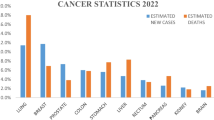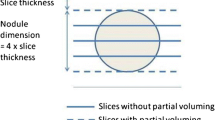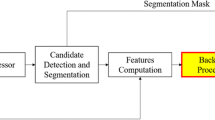Abstract
Objective
Computer-aided diagnosis (CADx) systems can be utilized to estimate the likelihood of malignancy of pulmonary nodules detected on CT scans. Such systems often require an initial segmentation step. We report on the impact of segmentation variations on the CADx output and describe methods for reducing this effect.
Methods
A total of 125 pulmonary nodules were evaluated using a CADx system based on genetic algorithms and ensemble classifiers. Two segmentation approaches were tested using leave-one-out validation: one approach included a free parameter chosen manually (manual) while the second used a parameter-free variant of the same algorithm (automatic).
Results
By varying the free parameter for the manual segmentation of the testing data, a set of likelihoods of malignancy was computed for each nodule. The mean range of these likelihoods was 0.36 (±0.23) and 0.45 (±0.27) using the manual and automatic segmentation approaches for the training data, respectively. Using training and testing data segmented with the automatic approach yielded an Az of 0.87 (±0.03). Similar results were obtained when the training and testing data were segmented using either approach.
Conclusion
Nodule segmentation can significantly affect CADx performance. A parameter-free segmentation was shown to match the performance of a skilled user while reducing potential user-to-user variability.
Similar content being viewed by others
References
Jemal A, Siegel R, Ward E, Murray T, Xu JQ, Thun MJ (2007) Cancer statistics, 2007. CA Cancer J Clin 57(1): 43–66
Gurney JW (1993) Determining the likelihood of malignancy in solitary pulmonary nodules with Bayesian analysis. Part I. Theory. Radiology 186(2): 405–413
Nakamura K, Yoshida H, Engelmann R, MacMahon H, Katsuragawa S, Ishida T et al (2000) Computerized analysis of the likelihood of malignancy in solitary pulmonary nodules with use of artificial neural networks. Radiology 214(3): 823–830
Way TW, Hadjiiski LM, Sahiner B, Chan HP, Cascade PN, Kazerooni EA et al (2006) Computer-aided diagnosis of pulmonary nodules on CT scans: Segmentation and classification using 3D active contours. Med Phys 33(7): 2323–2337. doi:10.1118/1.2207129
Suzuki K, Li F, Sone S, Doi K (2005) Computer-aided diagnostic scheme for distinction between benign and malignant nodules in thoracic low-dose CT by use of massive training artificial neural network. IEEE Trans Med Imaging 24(9): 1138–1150. doi:10.1109/TMI.2005.852048
Boroczky L, Lee MC, Zhao L, Agnihotri L, Powell CA, Borczuk AC et al (2007) Computer-aided diagnosis for lung cancer using a classifier ensemble. Int J CARS 2(Supp 1): S362–S364
Wiemker R, Rogalla P, Blaffert T, Sifri D, Hay O, Shah E et al (2005) Aspects of computer-aided detection (CAD) and volumetry of pulmonary nodules using multislice CT. Br J Radiol 78(Special Issue): S46–S56. doi:10.1259/bjr/30281702
Wiemker R, Rogalla P, Hein P, Blaffert T, Rosch P (2003) Computer-aided segmentation of pulmonary nodules: automated vasculature cutoff in thin- and thick-slice CT. 17th International congress on computer assisted radiology and surgery (CARS), London, pp 965–970
Kuhnigk JM, Dicken V, Bornemann L, Bakai A, Wormanns D, Krass S et al (2006) Morphological segmentation and partial volume analysis for volumetry of solid pulmonary lesions in thoracic CT scans. IEEE Trans Med Imaging 25(4): 417–434. doi:10.1109/TMI.2006.871547
Opfer R, Wiemker R (2007) A new general tumor segmentation framework based on radial basis function energy minimization with a validation study on LIDC lung nodules. In: Pluim JPW, Reinhardt JM (eds) SPIE medical imaging 2007: image processing, vol 6512. SPIE, San Diego
Erasmus JJ, Connolly JE, McAdams HP, Roggli VL (2000) Solitary pulmonary nodules: Part I. Morphologic evaluation for differentiation of benign and malignant lesions. Radiographics 20(1): 43–58
Li F, Sone S, Abe H, Macmahon H, Doi K (2004) Malignant versus benign nodules at CT screening for lung cancer: comparison of thin-section CT findings. Radiology 233(3): 793–798. doi:10.1148/radiol.2333031018
Sadjadi FA, Hall EL (1980) 3-Dimensional moment invariants. IEEE Trans Pattern Anal Mach Intell 2(2): 127–136
Granlund GH (1972) Fourier preprocessing for hand print character recognition. IEEE Trans Comput C 21(2): 195–201
McNitt-Gray MF, Har EM, Wyckoff N, Sayre JW, Goldin JG, Aberle DR (1999) A pattern classification approach to characterizing solitary pulmonary nodules imaged on high resolution CT: preliminary results. Med Phys 26(6): 880–888. doi:10.1118/1.598603
Sahiner B, Chan HP, Petrick N, Helvie MA, Goodsitt MM (1998) Computerized characterization of masses on mammograms: the rubber band straightening transform and texture analysis. Med Phys 25(4): 516–526. doi:10.1118/1.598228
Baraldi A, Parmiggiani F (1995) An investigation of the textural characteristics associated with gray-level cooccurrence matrix statistical parameters. IEEE Trans Geosci Rem Sens 33(2): 293–304. doi:10.1109/36.377929
Haralick RM, Shanmuga K, Dinstein I (1973) Textural features for image classification. IEEE Trans Syst Man Cybern SMC- 3(6): 610–621. doi:10.1109/TSMC.1973.4309314
Amadasun M, King R (1989) Textural features corresponding to textural properties. IEEE Trans Syst Man Cybern 19(5): 1264–1274. doi:10.1109/21.44046
Chen CC, Daponte JS, Fox MD (1989) Fractal feature analysis and classification in medical imaging. IEEE Trans Med Imaging 8(2): 133–142. doi:10.1109/42.24861
Bishop CM (1995) Neural networks for pattern recognition. Oxford University Press, New York
Kuncheva LI (2004) Combining pattern classifiers: methods and algorithms. Wiley, Hoboken
Eshelman L (1991) The CHC adaptive search algorithm: how to have a safe search when engaging in nontraditional genetic recombination. In: Rawlins GJE (eds) Foundations of genetic algorithms I. Morgan Kaufmann, San Francisco
Guerra-Salcedo C, Whitley DL (1998) Genetic search for feature subset selection: a comparison between CHC and GENESIS. Third Annual Conference for Genetic Programming, Madison
Guerra-Salcedo C, Whitley D (1999) Feature selection mechanisms for ensemble creation: a genetic search perspective. In: Freitas AA (ed) AAAI-99 and GECCO-99 workshop on data mining with evolutionary algorithms: research directions. AAAI Press, pp 13–17
Zhao BS, Yankelevitz D, Reeves A, Henschke C (1999) Two-dimensional multi-criterion segmentation of pulmonary nodules on helical CT images. Med Phys 26(6): 889–895. doi:10.1118/1.598605
Wiemker R, Zwartkruis A et al (2001) Optimal thresholding for 3D segmentation of pulmonary nodules in high resolution CT. In: Lemke HU (eds) 15th International Congress on Computer Assisted Radiology and Surgery (CARS), vol 1230. Elsevier, Berlin, pp 653–658
Li Q, Doi K (2006) Reduction of bias and variance for evaluation of computer-aided diagnostic schemes. Med Phys 33(4): 868–875. doi:10.1118/1.2179750
Metz CE, Herman BA, Shen JH (1998) Maximum likelihood estimation of receiver operating characteristic (ROC) curves from continuously-distributed data. Stat Med 17(9): 1033–1053 doi:10.1002/(SICI)1097-0258(19980515)17:9<1033::AID-SIM784>3.0.CO;2-Z
Zhao L, Lee MC, Boroczky L, Vloemans V, Opfer R (2008) Comparison of computer-aided diagnosis performance and radiologist readings on LIDC pulmonary nodule dataset. In: Sonka M, Manduca A (eds) SPIE medical imaging 2008: computer-aided diagnosis. SPIE, San Diego
Author information
Authors and Affiliations
Corresponding author
Rights and permissions
About this article
Cite this article
Lee, M.C., Wiemker, R., Boroczky, L. et al. Impact of segmentation uncertainties on computer-aided diagnosis of pulmonary nodules. Int J CARS 3, 551–558 (2008). https://doi.org/10.1007/s11548-008-0257-y
Received:
Accepted:
Published:
Issue Date:
DOI: https://doi.org/10.1007/s11548-008-0257-y




